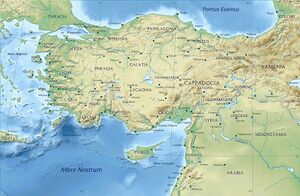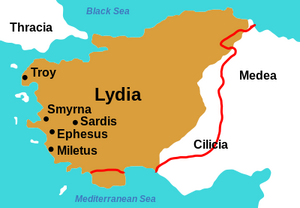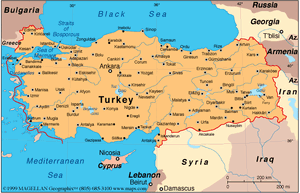Miletus
| Author: Laxman Burdak, IFS (R). |


Miletus was an ancient Greek city on the western coast of Anatolia, near the mouth of the Maeander River in ancient Ionia.[1][2][3] Its ruins are located near the modern village of Balat in Aydın Province, Turkey. The inhabitants of Miletus are called Milesians.
Variants
- Milētus and Milesians (Anabasis by Arrian, p. 53-58, 149, 204, 275, 354, 385.)
- Miletus (Pliny.vi.39)
- /maɪˈliːtəs/
- Greek: Μῑ́λητος
- romanized: Mī́lētos or Miletos
- Hittite transcription Millawanda or Milawata (exonyms)
- Latin: Mīlētus
- Turkish: Milet
- Milesians - the inhabitants of Miletus
- Milesian (Pliny.vi.2, Pliny.vi.32)
- Balat is a village in the District of Didim, Aydın Province, Turkey. The ruins of the ancient Greek city of Miletus are near the village.
Jat Gotras Namesake
- Meel = Milētus and Milesians (Anabasis by Arrian, p. 53-58, 149, 204, 275, 354, 385.)
Jat Gotras Namesake
- Meel = Miletus (Pliny.vi.39)
- Meel = Milesian (Inhabitants of Miletus or Milawata) (Pliny.vi.2, Pliny.vi.32)
Location

Its ruins are located near the modern village of Balat in Aydın Province, Turkey. Balat is village in the District of Didim, Aydın Province, Turkey.
History
Before the Persian rule that started in the 6th century BC, Miletus was considered among the greatest and wealthiest of Greek cities.[4][5]
Evidence of first settlement at the site has been made inaccessible by the rise of sea level and deposition of sediments from the Maeander. The first available evidence is of the Neolithic. In the early and middle Bronze Age the settlement came under Minoan influence. Legend has it that an influx of Cretans occurred displacing the indigenous Leleges, and the site was renamed Miletus after a place in Crete.
Recorded history at Miletus begins with the records of the Hittite Empire, and the Mycenaean records of Pylos and Knossos, in the Late Bronze Age. Miletus was a Mycenaean stronghold on the coast of Asia Minor from c. 1450 to 1100 BC.
The 13th century BC saw the arrival of Luwian language speakers from south central Anatolia calling themselves the Carians. Later in that century other Greeks arrived. The city at that time rebelled against the Hittite Empire. After the fall of that empire the city was destroyed in the 12th century BC and starting about 1000 BC was resettled extensively by the Ionian Greeks. Legend offers an Ionian foundation event sponsored by a founder named Neleus from the Peloponnesus.
The Greek Dark Ages were a time of Ionian settlement and consolidation in an alliance called the Ionian League. The Archaic Period of Greece began with a sudden and brilliant flash of art and philosophy on the coast of Anatolia. In the 6th century BC, Miletus was the site of origin of the Greek philosophical (and scientific) tradition, when Thales, followed by Anaximander and Anaximenes (known collectively, to modern scholars, as the Milesian school), began to speculate about the material constitution of the world, and to propose speculative naturalistic (as opposed to traditional, supernatural) explanations for various natural phenomena.
Milesians
The Milesians were the inhabitants of Miletus, an ancient Greek city in Anatolia, modern-day Turkey, near the coast of the Mediterranean Sea and at the mouth of the Meander River. Settlers from Crete moved to Miletus sometime in 16th century BC. By the 6th century BC, Miletus had become a maritime empire, and the Milesians spread out across Anatolia and even as far as the Crimea and Olbia, Ukraine, founding new colonies.
Towns founded by Milesians
- Cepi (Pliny.vi.6)
- Callatis (Arrian:The Anabasis of Alexander/6b, Ch.23)
- Mastya (Pliny.vi.2)
- Kertch (Pliny.vi.7)
- Naucratis (The Anabasis of Alexander/3a,Ch.5)
Archaeological evidence
The earliest available archaeological evidence indicates that the islands on which Miletus was originally placed were inhabited by a Neolithic population in 3500–3000 BC.[6] Pollen in core samples from Lake Bafa in the Latmus region inland of Miletus suggests that a lightly grazed climax forest prevailed in the Maeander valley, otherwise untenanted. Sparse Neolithic settlements were made at springs, numerous and sometimes geothermal in this karst, rift valley topography. The islands offshore were settled perhaps for their strategic significance at the mouth of the Maeander, a route inland protected by escarpments. The graziers in the valley may have belonged to them, but the location looked to the sea.
Mention by Pliny
Pliny[7] mentions....Beyond this river (river Billis) begins the nation of Paphlagonia1, by some writers called Pylæmenia2; it is closed in behind by the country of Galatia. In it are Mastya3, a town founded by the Milesians, and then Cromna4, at which spot Cornelius Nepos also places the Heneti5, from whom he would have us believe that the Veneti of Italy, who have a similar name, are descended.
1 Paphlagonia was bounded by Bithynia on the west, and by Pontus on the east, being separated from the last by the river Halys; on the south it was divided by the chain of Mount Olympus from Phrygia in the earlier times, from Galatia at a later period; and on the north it bordered on the Euxine.
2 In the Homeric catalogue we find Pylæmenes leading the Paphlagonians as allies of the Trojans; from this Pylæmenes the later princes of Paphlagonia claimed their descent, and the country was sometimes from them called Pylæmenia.
3 Suspected by Hardouin to have been the same as the Moson or Moston mentioned by Ptolemy as in Galatia.
4 It is mentioned by Homer, Il. ii. 855, as situate on the coast of Paphlagonia.
5 Strabo also, in B. xii., says that these people afterwards established themselves in Thrace, and that gradually moving to the west, they finally settled in the Italian Venetia, which from them took its name. But in his Fourth Book he says that the Veneti of Italy owe their origin to the Gallic Veneti, who came from the neighbourhood known as the modern Vannes.
Mention by Pliny
Pliny[8] mentions Arabia....Ampelome57 also, a Milesian colony, the town of Athrida, the Calingii, whose city is called Mariva58, and signifies "the lord of all men;" the towns of Palon and Murannimal, near a river by which it is thought that the Euphrates discharges itself, the nations of the Agrei and the Ammonii, the town of Athenæ, the Caunaravi, a name which signifies "most rich in herds," the Coranitæ, the Œsani, and the Choani59. Here were also formerly the Greek towns of Arethusa, Larisa, and Chalcis, which have been destroyed in various wars.
57 Probably the same place as we find spoken of by Herodotus as Ampe, and at which Darius settled a colony of Miletians after the capture of Miletus, B. C. 494.
58 Hardouin remarks that Mariaba, the name found in former editions, has no such meaning in the modern Arabic.
59 Mentioned by Ovid in the Metamorphoses, B. v. 1. 165, et seq. Sillig, however, reads "Ciani."
Ch. 18 Alexander marches to Miletus and Occupies the Island of Lade
Men now came to him both from Magnesia[1] and Tralles, offering to surrender those cities; and to them he sent Parmenio, giving him 2,500 infantry from the Grecian auxiliaries, an equal number of Macedonians, and about 200 of the Cavalry Companions. He also sent Lysimachus, son of Agathocles,[2] with an equal force to the Aeolic cities,[3] and to as many of the Ionic cities[4] as were still under the Persians. He was ordered to break up the oligarchies everywhere, to set up the democratical form of government, to restore their own laws to each of the cities, and to remit the tribute which they were accustomed to pay to the foreigners. But Alexander himself remained behind at Ephesus, where he offered a sacrifice to Artemis and conducted a procession in her honour with the whole of his army fully armed and marshalled for battle.[5]
On the following day he took the rest of his infantry, the archers, the Agrianians, the Thracian cavalry, the royal squadron of the Companions, and three other squadrons in addition, and set out for Miletus. At his first assault he captured that which was called the outer city; for the garrison had evacuated it. There he encamped and resolved to blockade the inner city; for Hegesistratus, to whom the king Darius had entrusted the command of the garrison in Miletus, kept on sending letters before this to Alexander, offering to surrender Miletus to him. But then, having regained his courage from the fact that the Persian fleet was not far off, he made up his mind to preserve the city for Darius. But Nicanor, the commander of the Grecian fleet, anticipated the Persians by sailing into the port of Miletus three days before they approached; and with 160 ships he anchored at the island of Lade, which lies near Miletus.[6] The Persian ships arriving too late, and the admirals discovering that Nicanor had occupied the anchorage at Lade before them, they took moorings near Mount Mycale.[7] Alexander had forestalled them in seizing the island, not only by mooring his ships near it, but also by transporting into it the Thracians and about 4,000 of the other auxiliary troops. The ships of the foreigners were about 400 in number.
Notwithstanding the superiority of the Persian fleet, Parmenio advised Alexander to fight a sea-battle, expecting that the Greeks would be victorious with their fleet both for other reasons and especially because an omen from the deity made him confident of the result; for an eagle had been seen sitting upon the shore, opposite the sterns of Alexander's ships.[8] He also urged that if they won the battle, they would reap a great advantage from it in regard to their main object in the war; and if they were beaten, their defeat would not be of any great moment; for even as it was, the Persians held the sovereignty of the sea. He added that he was willing to go on board the fleet himself and to share the danger. However, Alexander replied that Parmenio was mistaken in his judgment, and did not explain the sign according to probability. For it would be rash for him with a few ships to fight a battle against a fleet far more numerous than his own, and with his unpractised naval force to contend against the disciplined fleet of the Cyprians and Phoenicians. Besides, he did not wish to deliver over to the foreigners on so unstable an element the advantage which the Macedonians derived from their skill and courage; and if they were beaten in the seabattle, their defeat would be no small hindrance to their final success in the war, both for other reasons, and especially because the Greeks, being animated with courage at the news of his naval defeat, would attempt to effect a revolution. Taking all these things into consideration, he declared that he did not think that it was a suitable time for fighting a sea-battle; and for his part, he expounded the divine omen in a different way. He admitted that the eagle was in his favour; but as it was seen sitting on the land, it seemed to him rather to be a sign that he should get the mastery over the Persian fleet by defeating their army on land.
1. This was the Carian Magnesia, situated on the Lethaeus, a tributary of the Maeander. Tralles was on the Eudon, another tributary of the Maeander. See Juxenal, iii. 70.
2. Lysimachus was of mean origin, his father having been a serf in Sicily. He was one of Alexander's confidential body-guards, and on the death of the great king obtained Thrace as his portion of the dismembered empire. In conjunction with Seleuous he won the battle of Ipsus, by which he obtained a great part of Asia Minor. He ultimately acquired all the European dominions of Alexander in addition to Asia Minor; but in his eightieth year he was defeated and slain by Seleuous at the battle of Corus, B.C. 281. Sintenis was the first to substitute Lysimachus for Antimachus, the reading of the MSS. Cf. vi. 28 infra.
3. Eleven in number. See Herodotus, i. 149-151.
4. Thirteen in number, of which Miletus and Ephesus were the chief in importance.
5. For the celebrated interview of Alexander with Apelles at Ephesus, see Aelian (Varla Historia, ii. 3).
6. Cf. Herodotus, vi. 7. Here the Persians destroyed the Ionic fleet, B.C. 497.
7. Famous for the victory won near it by Leotychides and Xanthippusover the Persians, B.C. 479.
8. Cf. Vergil (Aeneid, vi. 3). Obvertunt pelago proras. See Conington's note.
References
- ↑ Sharon R. Steadman; Gregory McMahon; John Gregory McMahon (15 September 2011). The Oxford Handbook of Ancient Anatolia: (10,000-323 BCE). Oxford University Press. p. 369 and 608. ISBN 978-0-19-537614-2.
- ↑ Luc-Normand Tellier, Urban World History: An Economic and Geographical Perspective, p. 79:
- ↑ Carlos Ramirez-Faria (1 January 2007). Concise Encyclopeida Of World History. Atlantic Publishers & Dist. pp. 305–. ISBN 978-81-269-0775-5.
- ↑ A Short History of Greek Philosophy By John Marshall page 11
- ↑ Ancient Greek civilization By David Sansone page 79
- ↑ Crouch, Dora P. (2004). Geology and Settlement: Greco-Roman Patterns. New York: Oxford University Press. ISBN 9780195083248, p.183
- ↑ Natural History by Pliny Book VI/Chapter 2
- ↑ Natural History by Pliny Book VI/Chapter 32
Back to Jat Places in Anatolia

